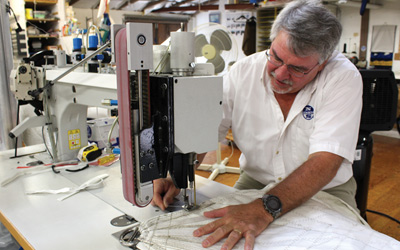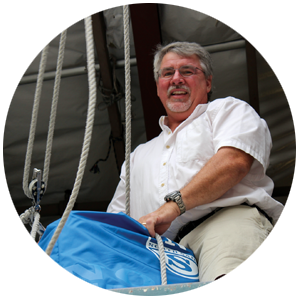“Thought is the wind, knowledge the sail, and mankind the vessel,”
—August Hare
The arrival of October signals to many competitive Pacific Northwest sailors that the fall sailing season is drawing nigh, and as a result sailmaking lofts are working overtime. The higher the winds, the faster the sewing machines whir. On the cruising side of the spectrum, owners fresh from summer cruising up north eye the coming rains and prepare accordingly for cloth-wrecking moisture.
The mind turns over many sail-related questions this time of year. Forward-thinking (aka smart) boaters think about their goals of their boating future. What kind of sail should I go for this season? How do I keep this mainsail from getting all gross and moldy?
We turned to Jack Christianson, the Loft Manager of the North Sails, for some expert advice on sails. The loft, right above Fisheries Supply in Seattle, was full of sails both new and old when we visited. Christianson graciously penciled us in during the morning before his booked-up day could whisk him onto the water and into marinas for clients. A lifelong sailor, collegiate sailing All-American, and sailmaker since 1983 when he started his own sailmaking company in college, Christianson is a wellspring of information.

Q: What’s the typical day like? Is it booked up with you in the field or are you in the loft most of the time?
Everyday is a big variety. A typical couple of days may be spent in the loft with my service manger completing repairs and preparing new sails for delivery. We like to put our sails on the boats in person with the customers after they purchase them to make sure the customers know how to use them, where the battens go, go over maintenance tips, and the like.
We’ll get quote requests over the internet from our national webpage and we’ll respond to those. If someone wants to order a sail, we’ll get those parameters in and define what sail we’re ordering for them. The process from order request to sail delivery usually takes about two months.
North Sails was founded in 1957 by Lowell North when he was 30 years old. In order to pursue a life of sailmaking, the story goes that North, a UC Berkeley graduate, left behind a budding aeronautic/aerospace engineer career. After winning the Star 23 1959 Midwinter Championship in Los Angeles with his innovative new mainsail design, North Sails rocketed onto the map. North pioneered the use of plastic finishing, radial construction, Mylar laminates, and computer use before selling his company in 1984. The company has continued to innovate and maintain its place as a top-tier sailmaking company, considered by most to be the largest in the world.
NorthSails.com // 206-632-5753

Q: I hear a lot about North Sails and how good they are through dock talk. Why? What makes them special and, in your experience with different makers and brands, do they deserve their reputation?
Yes! North Sails is the largest sailmaking business in the world. The company is incredibly diverse and is always pushing the edges of reality in terms of making sails. The 3Di sails, that we’ve been selling since their debut in 2010, are incredibly durable and used on both racing and cruising boats, as well as the Volvo 60 Around the World boats.
3Di stands for laminate integral sail and refers to North Sails’ patented technology that’s made of ultra-thin unidirectional spread filament tapes that’s pre-impregnated with thermoset adhesive and arranged into a three-dimensional, molded, flexible composite membrane. Under load, it has a rigid shape, meaning less distortion underway and hence, less wind resistance from air distortion.
Q: So is there a sharp divide between the types of sails used by racers and cruisers, or are there sail designs that are versatile for both?
What I find challenging with sailmaking is that you can have three different boat owners who own the same boat, yet they have different goals in mind and thus need different sails. Every job is essentially a custom job, a puzzle for me to solve.
North Sails has many products that may fundamentally be built the same way, but the way that the sails are finished, detailed, and reinforced differ widely. There are a lot of different options to choose from. By owning our own production facilities and the cloth and fabric, North Sails is completely unique. Nobody else does that.
We make sails for anybody, and most of our clientele are cruisers. We do the smallest El Toro or Optimist as well as the super yachts over 300 feet.
Q: What do you mean that “every job is a custom job?
Firstly, everyone is using their boats differently and need the proper sails for the use. Secondly, boats have odd quirks. For example, somebody installs a roller furler and the drum is at a different height for different anchors.
A new jibe needs to accommodate the dimensions. Even production boats, like a Cal 27 for example, are a little different from one another. We have to go measure them.
Q: Common vernacular I’ve heard is that if you see a black sail, it’s a racer. If you see a white sail, it’s a cruiser. Is that true?
Well, the racers tend to get new boats more often and tend to get new sails for those new boats more often, so they change and are a little more aesthetically oriented toward black or grey sails. The colors are aesthetically pleasing, mostly.
Cruisers are usually less concerned with certain aesthetics, and white is normal. Some these days are going with a grey finish, which is a newer trend now that the grey option is more common on the market.
Q: Do you have any pro tips keeping sails in good shape?
Yes. Pretty simple, but whenever you put your sail up or take your sail down, have your halyards and lines ready to minimize the amount of time the sail is luffing as it goes up or down. If possible, go behind a headland in order to hoist the sail up or down.
Look over your sail once a month to see if there’s any problems starting. Especially cruising sails; the sun tends to eat away at the threads, especially where the sacrificial cover is on.
If you can rub that with your fingernail and break the threads, you should bring it in to get re-stitched. You can re-stitch a few times before the cover needs to be replaced if you catch it early.

Jack Christianson is the Loft Manager of North Sails in Seattle. Christianson’s sailing roots go back to when he was a middle-schooler in Portland, Oregon, who was hooked on racing lasers. He continued his passion for sailing through his college years at the University of Washington, and started his own sailmaking company when in school in 1983. He was a collegiate All-American at UW with many notable wins. Christianson has been a sailmaker ever since with names like Shore Sails of Puget Sound, Uhlman Sails Northwest, and now North Sails. He has been with North Sails since 1995.
“I just wanted to keep sailing and racing, and this seemed like a good way to do it,” says Christianson.
Q: What kind of lifespan does a sail have? Can you sort of bring it back indefinitely with maintenance care?
There are sails in our loft that are 20 to 30 years old and still going strong. The important factor for a sail isn’t just age, it’s the number of hours of use, especially in the sun, that really determines the life of cruising sails.
The racing sails tend to be brought in a little earlier as the many eyes of a seasoned crew catch the early signs of trouble quickly. Competitive racers have to be pretty on the ball when it comes to the condition of their sails.
Q: As a sailmaker, where do the riggers come in? How do you handle the extra accessories like roller furlers, etc?
We arrange with different riggers to install the sails on customers’ boats. We advise or sell clients the hardware ranging from top-down furlers to gennakers to cruising spinnakers. The riggers are brought in early in the process and are usually present throughout installation.
There are a lot of options out there in terms of rigging, and it’s part of my job to give my client the best advice as to what hardware to buy in accordance to the specific job at hand.
Q: Do you have any tips for fall sail maintenance?
We’re coming up on the fall racing season, and we’re pretty lucky in the Northwest where we have great spring and fall sailing seasons. There’s great daytime winds when the summer heat goes away. When everyone goes sailing on the weekends, there will be wind again.
My best piece of advice is to get out there and sail your boat, as much as you’re tolerant of rain and cold, of course. Sails, and boats in general, tend to deteriorate when left idle and neglected in the slip for extended periods of time.
Q: What are some good ways for sailors to keep moisture away from their sails?
Take your sails off in the fall or early winter if you’re a cruiser. Give us a call if you want us to help. Removing your sails and storing them in a dry place will keep the green mildew from growing. The mildew is purely aesthetic, but it saves a cleaning bill down the road when you want your sails looking nice. Storing your sails just goes a long way to giving the sails a long and productive life.
If it’s raining out when you’re using your roller furler, you should return to the boat when there’s no wind and unfurl the sail to let it dry out. You don’t want to stow your sails wet.


